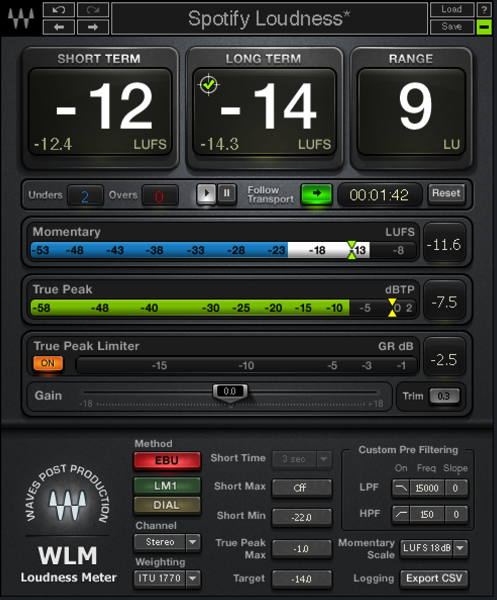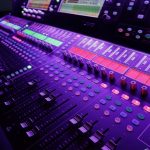
Chasing a “Loud” Streaming Mix

A frequent topic I see come up on social media relates to streaming audio levels and not being able to get streaming mixes “loud enough”. This is a “mastering” issue so I’m warning you we’re gonna have to get technical on this one.
First off, contrary to many discussions regarding audio, there is no such thing as a “loud” mix. There are mixes with high signal levels, and there are mixes with low signal levels. We may also have mixes with a lot of dynamics and mixes with little to no dynamics. We can have bright mixes or dark mixes or mixes that are somewhere in between. These are the things we control.
We DO NOT control loudness, though. Loudness is in the hands of the listener when it comes to streaming because the listener has control of the volume. They are in charge of how loud everything is. Maybe one of these days the audio industry will remember this.
So when we are talking about mixes that aren’t “loud enough”, we’re really talking about mixes that don’t have a high enough signal level. In particular, we’re really talking about mixes that don’t have a high enough average signal level. The average part is important because as humans we are far more sensitive to the average level of things. This is why an instantaneous 1k blip with a high signal level is less likely to bother us compared to a droning 1k sine wave at the same signal level. The blip is an instant and a drone is, well, droning over a period of time.
In order to get a mix with a high average signal level, the first thing we need is a good mix. Not sure how your mix actually stands up? Level match a high quality commercial release to it and A/B between your mix the commercial release. If your mix isn’t where you want to get it, we should talk because I can help you get there.
Now, let’s talk some technical stuff.
Digital audio signal levels are measured “FS” which stands for “Full Scale”. Full scale is the maximum amount of level that is technically possible in digital audio and is typically represented as 0 dBFS. If 0 dBFS is the top of the scale, that means everything below 0 dBFS will be a “-” value.
Now, there are a number of ways to measure or meter our signal level, and they can all tell us different things. In this case, the first meter we want access to is a standard Peak Meter. This displays the peak signal level of our digital audio signal which is important to know so we don’t end up pushing more level than our digital system can handle. If our levels rise above 0, our audio will clip resulting in nasty digital distortion which is quite different from the cool, hip analog distortion many of us enjoy hearing. There’s nothing above 0 but distortion. When our signal hits 0, it’s game over. Some of this nastiness may not be as obvious if you are just kissing 0 for microseconds. But the distortion is there and the longer you hit it, the more audible the nastiness gets. Streaming audio codecs don’t like audio that’s getting pushed this much, either, but more on that in a bit.
The next meter we need access to is a Loudness Meter. I wrote a series of posts about loudness measurements a few years back, so I’ll keep this simple today. A Loudness Meter provides an averaged measurement of our signal after it has been filtered to emphasize the area of the frequency spectrum we associate with loudness. The real reason this meter matters, though, is because it’s the type of measurement broadcasters and streaming platforms utilize for loudness normalization today.
YouTube and Spotify, for example, currently normalize audio to around -14 LUFS/LKFS. This means they measure the average level over the course of an entire video/song and adjust or normalize its level to -14 LUFS. This is known as an Integrated or Long-Term measurement since it encompasses the entire program.
By the way, LUFS stands for Loudness Units Full Scale. US broadcasters use LKFS which is the exact same thing as LUFS–it’s just a different terminology.
Another important 2021 streaming loudness number is -16 LUFS which is what Apple uses for podcasts and AES recommends for streaming content. These numbers are subject to change in the future, but as of today they are good to go by.
But what does this mean for OUR streaming content?
If we want our streaming audio to play at a level on par wtih what people are used to experiencing in 2021, we want the Integrated/Long-Term level of our program to be between -16 LUFS and -14 LUFS. This way if we are streaming on a platform that doesn’t do any loudness normalization, our levels will already be in the right ballpark.
Now, I have a couple of notes on this. When we start getting technical and worrying about numeric values on a meter, it’s easy to start chasing that meter while mixing. This is a bad idea.
These standards don’t mean we need a constant level of -14 LUFS for our program. We can have moments that are louder and moments that are quieter. For example, I find the music I mix measures higher using a Short Term measurement than speech measures. That’s natural.
When you are mixing, just mix. Use your ears and listen to how it sounds. If you want a solid piece of advice to start with, get your vocals up so they are as loud as speech. You might even be able to cheat the vocals up a tick, but in general just mix so vocals naturally feel around as loud as speech and vice-versa. Then build everything else around that the way you normally would in order to get a good mix.
When I’m mixing in my studio, My mixes generally sit around -24 LKFS because that is the US standard for broadcasting. It’s also very close to the level we mixed at back in the analog days so it just works for me. If you’re wondering how I do this, a big part of it is through the use of calibrated monitors.
This means my mixes don’t default to a “streaming level”, though.
So how do you get a mix that is below the streaming level up to the proper level?
A Mastering Limiter.
Mastering Limiters–sometimes referred to as Maximizers–generally work by raising the signal level towards a brickwall ceiling. When the signal hits that ceiling, the limiter attenuates it preventing it from going above the ceiling.
I recommend setting the ceiling to -1.0 dBFS. Streaming audio codecs do funky things to audio at times and they don’t always play nice with high level signals. -1.0 dBFS gives them headroom for their processing which can minimize artifacts. Some engineers say you can go a little higher than -1.0, but I like -1.0.
For my mixes, I simply raise my level with the limiter or maximizer until I am at the proper level. That’s a bit of an oversimplification because limiters also have release controls to deal with and some have different algorithms that affect the sound as well. If you’re new to things, though, I’d suggest starting with an auto release setting.
There is definitely a little more to this, but I’ll save that for another time.
If you are struggling with the quality of your streaming mix, and you’re looking for more specific help, I would love to chat about how some remote coaching and maybe even training could help. Head over to my Contact page and leave me a message.

 Previous Post
Previous Post Next Post
Next Post



Hey Dave – thanks for the great article. Do you recommend for church live streams to youtube and facebook to try to target -16LUFS or -24LUFS?
For anything streaming I would recommend between -16 and -14 LUFS.